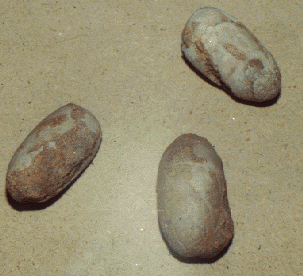
Gobipteryx
sp. eggs
Sauriurae: Enantiornithes: Alexornithidae
Locality: Khermeen
Tsav, Gobi Desert, southern Mongolia
Age: Late Cretaceous (Campanian), 75
million years ago
Gobiopteryx
is one of the most ancient of birds. It is known from two crushed skulls and
lower
jaws from Mongolia.
When Gobipteryx lived, birds were
just beginning to develop into the groups
we know today. The oldest vertebrate
that has been called a bird is the first
vertebrate with feathers, Archaeopteryx,
from the Late Jurassic of Germany.
During the end of the Age of Dinosaurs, primitive
birds experimented with many
different forms and niches, and it wasn't until the
early stages of the Cenozoic, the Age of
Mammals (beginning at 65 million years
ago), that the broad outlines of modern
groupings of birds could be seen.
Gobipteryx
still has many reptilian characteristics.
One example, one of the bones of the
jaw,
the quadrate, resembles bones in theropod dinosaurs.
But Gobiopteryx also
had bird-like features too.
Many paleontologists view Gobipteryx and a number
of other Cretaceous
birds as early experiments in bird-like features that didn't
give rise to any later birds.
These experimented with the avian form until crowded
out by better competitors.
These better competitors gave rise to our modern birds.
Gobipteryx
would have had feathers and probably would have been able to fly.




